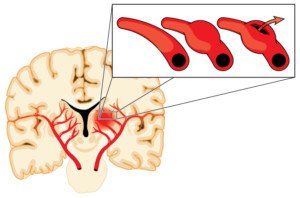![]()
High blood pressure, not just brain tumors and sinus infections, can cause headaches.
Hypertension can also cause an aneurysm in the brain – a bulging blood vessel that can burst and cause life-threatening bleeding.
First off, high blood pressure (hypertension) is often referred to as the “silent killer.”
Typically it does not cause symptoms. Typically. That’s the key word.
This is why everyone should regularly get their BP measured with a home device in addition to at a medical clinic.
There is no such thing as, “I can’t have high blood pressure because I feel fine.”
High Blood Pressure and Headaches
Now, in occasional cases, high BP can cause symptoms.
“When blood pressure is elevated, it can often cause a flushed face as well as a headache,” says Walter Gaman, MD, FABFM, board certified in family medicine and the author of several award-winning books including “Age to Perfection: How to Thrive to 100, Happy, Healthy, and Wise.”
“While the American Heart Association takes the stance that high blood pressure does not cause headaches, some scientists and physicians around the world disagree.
“When the heart is working too hard it causes the pressure within the blood vessels to increase.
“The top number, the systolic, represents the heart at work, while the bottom number, the diastolic, represents the heart at rest.
“When someone develops high blood pressure it can increase the pressure of the vessels around the skull.
“Those vessels then begin a processes called autoregulation. In some studies, autoregulation can reduce headaches, specifically if the blood pressure was mostly a systolic elevation.
“However, for people with high blood pressure who develop significant headaches, their body may not be regulating the vessels around the brain, thus causing pressure.
“For those people, headaches may be the first sign of high blood pressure.”

Shutterstock/wavebreakmedia
If you’ve been experiencing bad headaches lately, they are most likely of benign origin such as muscle tension, stress or a sinus issue. Even a tight ponytail can cause a headache.
Brain tumors are uncommon causes of headache. Hypertension, too, is not a common cause, but it’s more likely the culprit than is a brain tumor.
Nevertheless, high BP is a heavyweight in the department of potentially life-threatening conditions.
High Blood Pressure and Brain Aneurysm
“Someone with untreated hypertension can be at risk for a cerebral aneurysm,” says Dr. Gaman.
“This is especially true if they also have a history of smoking cigarettes. The uncontrolled hypertension puts pressure on the blood vessel, causing it to become weak.
“Much like a balloon that has been stretched with inflation, deflated and inflated again. Over time, this causes the balloon to lose elasticity.
“The arteries are the same way, becoming weak when over-stretched. If an artery then bursts, it can create a hemorrhage, where blood leaks out into the brain.

Shutterstock/Blamb
“This is a life-threatening condition. This is one of the reasons that controlling high blood pressure is so important.”
This condition is also called a hemorrhagic stroke. For many who survive this event, they suffer permanent brain damage (depending on which area of the brain got soaked with blood).
Usually, an unruptured cerebral aneurysm does not cause symptoms. However, there are cases in which for a few weeks prior to the rupture, the patient began experiencing headaches.
Beware of this Symptom Triad
A classic symptom trio is highly suspicious for a brain aneurysm:
• Headache
• One eyelid drooping
• Pupils of noticeably unequal size
There may also be double vision. If you’re having any of these symptoms along with a headache, you should be driven to the emergency room.
Though headaches as solitary symptoms normally don’t mean anything sinister, the game changes when the other symptoms are present. Get to the ER!
Avoiding Hypertension
To keep your blood pressure from getting high, here is what you must do.
Quit smoking, increase your consumption of fresh produce, lower your consumption of processed and high sodium foods, maintain a healthy body weight, and do cardio and strength training workouts.

Freepik.com

Dr. Gaman is with Executive Medicine of Texas and is with the Staying Young Radio Show 2.0 podcast.
 Lorra Garrick has been covering medical, fitness and cybersecurity topics for many years, having written thousands of articles for print magazines and websites, including as a ghostwriter. She’s also a former ACE-certified personal trainer.
Lorra Garrick has been covering medical, fitness and cybersecurity topics for many years, having written thousands of articles for print magazines and websites, including as a ghostwriter. She’s also a former ACE-certified personal trainer.
.













